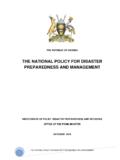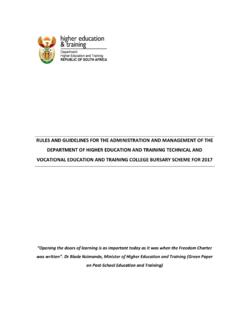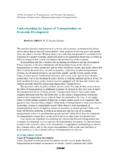Transcription of Governing land for women and men - Food and Agriculture ...
1 GOVERNANCE OF TENURE TECHNICAL GUIDE. 1. Governing land for women and men A technical guide to support the achievement of responsible gender-equitable governance of land tenure GOVERNANCE OF TENURE TECHNICAL GUIDE No. 1. Governing land for women and men A technical guide to support the achievement of responsible gender-equitable governance land tenure F O O D A N D A G R I C U LT U R E O R G A N I Z AT I O N O F T H E U N I T E D N AT I O N S. RO ME, 2013. First reprint: January 2013. Second reprint: June 2013. The designations employed and the presentation of material in this information product do not imply the expression of any opinion whatsoever on the part of the Food and Agriculture Organization of the United Nations (FAO) concerning the legal or development status of any country, territory, city or area or of its authorities, or concerning the delimitation of its frontiers or boundaries.
2 The mention of specific companies or products of manufacturers, whether or not these have been patented, does not imply that these have been endorsed or recommended by FAO in preference to others of a similar nature that are not mentioned. The views expressed in this information product are those of the author(s). and do not necessarily reflect the views or policies of FAO. ISBN 978-92-5-107403-9 (print). E-ISBN 978-92-5-107724-5 (PDF). FAO 2013. FAO encourages the use, reproduction and dissemination of material in this information product. Except where otherwise indicated, material may be copied, downloaded and printed for private study, research and teaching purposes, or for use in non-commercial products or services, provided that appropriate acknowledgement of FAO as the source and copyright holder is given and that FAO's endorsement of users' views, products or services is not implied in any way.
3 All requests for translation and adaptation rights, and for resale and other commercial use rights should be made via licencerequest or addressed to FAO information products are available on the FAO website ( publications) and can be purchased through III. Acknowledgements This technical guide on Governing land for women and men has been prepared by a team led by Elizabeth Daley and including Clara Mi Young Park, Francesca Romano, Leila Shamsaifar, Ting-Hui Lau and Babette Wehrmann. The guide was drafted by Elizabeth Daley and Clara MiYoung Park, with other contributors of material and content including Judy Adoko, Dalal Alnaggar, Marianna Bicchieri, Patricia Costas, Kate Dalrymple, Nigel Edmead, Debra Anne Fletcher, Seema Gaikwad, Catherine Gatundu, Ren e Giovarelli, Paolo Groppo, Nora Heil, Adriana Herrera-Garibay, Rachael Knight, Annalisa Mauro, Eliane Najros, Esther Obaikol, Martha Osorio, Sabine Pallas, Neil Pullar, Peter Rabley, Rebecca Sittie, Elizabeth Stair, Josephine Stowers-Fiu, Mika- Petteri T rh nen, Margret Vidar and Babette Wehrmann.
4 The guide benefited from comments from Dubravka Bojic, Paolo Groppo, Paul Munro-Faure, Ana Paula de la O Campos, Martha Osorio, David Palmer, Neil Pullar, Francesca Romano, Margret Vidar and Babette Wehrmann. It has been externally peer reviewed by Bayarmaa Byambaa, Catherine Gatundu, Ren e Giovarelli, Susana Lastarria-Cornhiel, Sabine Pallas, Siraj Sait, Agatha Wanyonyi and the German Working Group on land hosted by the German Agency for International Cooperation (GIZ). The editing of the guide was by Jane Shaw and the layout by Luca Feliziani. FAO thanks the International Fund for Agricultural Development (IFAD) for funding the development and preparation of this technical guide.
5 IV Governing land FOR women AND MEN. Foreword On 11 May 2012, the Committee on World Food Security endorsed the Voluntary Guidelines on the Responsible Governance of Tenure of land , Fisheries and Forests in the Context of National Food Security (the Guidelines). Based on the principles of sustainable development and in recognition of land 's centrality to development, these Guidelines are intended to contribute to global and national efforts towards the eradication of hunger and poverty by promoting secure tenure rights and equitable access to land , fisheries and forests. This technical guide on Governing land for women and men aims to assist implementation of the Guidelines' principle of gender equality through the achievement of responsible gender-equitable governance of land tenure.
6 Preparation of this guide included substantive research and consultation, leading to the production of an FAO working paper in February 2011, Governing land for women and men gender and voluntary guidelines on responsible governance of tenure and other natural resources (FAO, 2011a). The working paper analysed and identified the main themes and issues to be covered by this guide. To help identify good practice for responsible gender-equitable governance of land tenure, a technical workshop was held in May 2011 at FAO Headquarters in Rome. Governing land for women and Men a Workshop on Gender-Equitable Governance of land Tenure brought together land sector practitioners from government, civil society and the private sector around the world to share practical, hands-on experiences and approaches to improving gender equity in land tenure governance.
7 The outcomes of this workshop have contributed immensely to enriching this guide. After endorsement of the Guidelines, the drafting team finalized this technical guide through a process that included peer review. Alexander M ller Assistant Director-General FAO Natural Resources Management and Environment Department V. Contents iii MODULE 2: Acknowledgments Legal-issues iv 27. Foreword Introduction 28. Introduction Legal pluralism from a gender perspective 3. What is this guide about? 33. Drafting of laws, regulations and 4 procedures What are the scope and limitations of this guide? 37. Gender-equitable land tenure 5 governance and exercising rights to Why a technical guide on gender- land equitable governance of land tenure?
8 46. 5 Summary of key messages on legal What key issues do the modules cover? issues 6 47. Who is this guide for, and how should it References be used? 8. References MODULE 3: Institutions MODULE 1: Policy-making 51. Introduction 11. Introduction 51. land tenure governance institutions 11. Distinguishing between land policies 55. and governance in land policy-making land -related institutions 12 58. Building gender-equitable participation Other institutions into land policy-making processes 59. 17 Capacity development for gender- Stakeholders' roles in gender-equitable equitable land tenure governance land policy-making institutions 21 60. Local-level land Gender-equitable representation in policy-making technical professions 22 63.
9 Summary of key messages on Summary of key messages on policy-making institutions 24 64. References References VI Governing land FOR women AND MEN. MODULE 4: 101. Technical issues Summary of key messages on getting the message across 67 102. Introduction References 68. General land administration and management issues 70 Resources and references Recording tenure rights 103. 71 Introduction land survey, titling and registration 103. 76 Presentations at the May 2011 technical Valuation workshop 77 104. Taxation References and further reading 77 109. land -use planning Further resources for gender-equitable 79 governance of land tenure land consolidation and readjustment 110.
10 80 International land redistribution and restitution instruments in support of gender- 82 equitable governance of land tenure Redistributive reforms 83. Compensation 84. Summary of key messages on technical issues 86. References MODULE 5: Getting the message across 89. Introduction 89. Awareness-raising, gender sensitization and advocacy 93. Legal literacy 94. Communication and awareness-raising strategies and methods 100. Changing values and attitudes Introduction LIST. of ILLUSTRATIONS. Boxes 3. Box 1: The Guidelines' Tables and figures principles of implementation 4. relevant to gender equity Table 1: Definitions and equality 6. 5 Table 2: Contents of this Box 2: CEDAW provisions guide supporting gender- 7.















